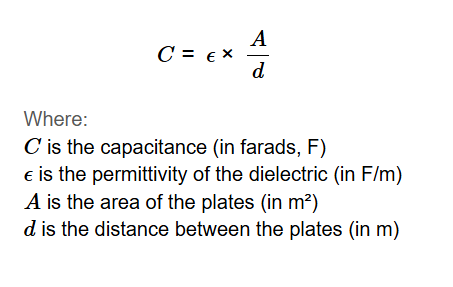 Home
Home
 Back
Back

Definition: This calculator computes the capacitance of a parallel-plate capacitor based on the permittivity of the dielectric material, the area of the plates, and the distance between the plates.
Purpose: It is used in electronics and circuit design to determine the capacitance of a parallel-plate capacitor, which is essential for applications like filtering, energy storage, and signal processing.
Capacitance is calculated using:
Where:
Steps:
Details: Capacitance determines a capacitor's ability to store charge, which is critical in electronic circuits for tasks like filtering signals, storing energy, and stabilizing voltage. Accurate calculation ensures proper circuit design and performance.
Tips: Enter the permittivity (with unit), plate area (with unit), and distance between plates (with unit). For distance units like ft/in or m/cm, enter the major and minor units separately (e.g., 1 ft 6 in). The result will be the capacitance in farads (F), millifarads (mF), microfarads (µF), nanofarads (nF), and picofarads (pF), with 5 decimal places. Small values are shown in scientific notation for clarity.
Examples:
Q: What is capacitance?
A: Capacitance is the ability of a capacitor to store electric charge, measured in farads (F). It depends on the geometry of the capacitor and the dielectric material between the plates.
Q: What is permittivity?
A: Permittivity (\( \epsilon \)) is a measure of how much a dielectric material can enhance the capacitance of a capacitor compared to a vacuum. For a vacuum, it is \( 8.854 \times 10^{-12} \, \text{F/m} \).
Q: Why are small capacitance values displayed in scientific notation?
A: Values less than 0.00001 (e.g., \( 1 \times 10^{-5} \)) are displayed in scientific notation for clarity, as they would otherwise show as long strings of zeros in decimal format.
Q: Why are results shown in multiple units?
A: Capacitance values can vary widely in magnitude. Displaying the result in farads (F), millifarads (mF), microfarads (µF), nanofarads (nF), and picofarads (pF) provides flexibility for different applications, as some contexts may use smaller units like pF or µF.
Q: How do I use the ft/in or m/cm units for distance?
A: Select ft/in or m/cm from the distance unit dropdown. Then, enter the major unit (e.g., feet or meters) and the minor unit (e.g., inches or centimeters) in the two fields that appear. For example, for 1 foot 6 inches, enter 1 in the first field and 6 in the second.
Q: Why are there multiple units for permittivity?
A: Permittivity can be expressed in different units depending on the context. The calculator supports F/m, pF/m, nF/m, µF/m, and mF/m, converting all inputs to F/m for the calculation.